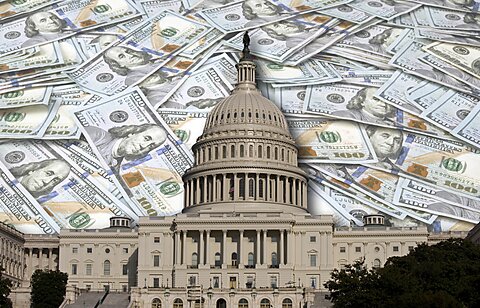At the end of 2017, Congress passed the Tax Cuts and Jobs Act (TCJA). The law included wide‐ranging reforms that simplified and cut taxes for Americans at every income level. By lowering business taxes, the law boosted investment, wages, and economic growth.
At the end of 2025, basically all the individual tax cuts and some of the most economically consequential business provisions expire.
The coming 2025 fiscal cliff presents both challenges and opportunities for tax and budget reform. President Joe Biden recently floated “principles” for dealing with the tax cut’s expiration, pairing them with unspecified tax hikes on Americans earning over $400,000 a year. Former President Donald Trump has also suggested he’d extend and expand the tax cuts, pairing them with potentially extensive new tariffs. Whether paid for with tariffs or new taxes on investment and wealth, both 2025 presidential candidate’s proposals would come with high economic costs that would undermine any economic gains from extending the TCJA.
A new Cato Policy Analysis presents a more aggressively pro‐growth proposal for post‐TCJA tax reform. The Cato plan lays out a roughly revenue‐neutral reform that slashes tax rates to near 100‐year lows while dramatically simplifying and streamlining the tax code by repealing more than $1.4 trillion in annual tax loopholes. The plan also discusses the dire need for spending cuts to ensure taxes can stay low for the long term.
The Road To (and From) the TCJA
Before the TCJA, congressional Republicans built consensus around the reform’s main parameters. In 2014 and again in 2016, Dave Camp and Paul Ryan, the chairmen of the Ways and Means Committee, each released comprehensive tax reform discussion drafts. Presidential campaigns, including Trump’s 2016 campaign, also released proposals. These proposals were primarily motivated by a consensus—which was also widely shared by Democrats, including then‐President Barack Obama—that the US business tax system was globally uncompetitive. America’s high corporate tax rate and outdated international tax rules resulted in significant losses of domestic investment, business headquarters, and jobs.
While deficit concerns from some senators in 2017 limited the size of the TCJA’s revenue reduction to $1.5 trillion over ten years, the 2017 fiscal outlook was very different than today. Since 2017, the federal government has almost doubled the size of the national debt, adding more than $12 trillion to the national credit card, due primarily to additional spending.
In the current fiscal environment, with spending projected to increase faster than the economy, extending the tax cuts without offsetting spending or tax changes is fiscally unsustainable. Congress cannot keep tax revenue flat while increasing spending year after year.
Despite this reality, there is general bipartisan agreement on keeping a majority of the 2017 tax cuts. Republicans and Democrats both agree on keeping the tax cuts for Americans earning less than $400,000 a year—which would reduce revenue somewhere in the ballpark of $2.8 trillion, depending on the details, or about 60 percent of the roughly $4.8 trillion ten‐year total cost of extension.
It’s not just politicians who have begun outlining how they might deal with the TCJA’s expiration—albeit with serious details lacking. Washington, DC, policy groups and individual scholars have also released plans to deal with the TCJA expirations.
The Tax Foundation outlines two revenue‐neutral, pro‐growth options for extending the TCJA, working within the law’s broader framework. The Tax Foundation has also proposed an entirely new tax system modeled on the Estonian flat tax.
Kyle Pomerleau and Donald Schneider outline two revenue‐neutral, pro‐growth options for extending the TCJA, one working within the law’s framework and another proposal that includes a new tax system for business income.
Kimberly Clausing and Natasha Sarin outline a plan to extend and expand some of the TCJA low‐income tax subsidy programs, let many of the individual tax cuts expire, increase taxes on businesses, estates, and investment income, and add a carbon tax to raise more than $3 trillion in new revenue over 10 years.
Other notable mentions include revenue proposals within larger budget reform blueprints, such as by the Heritage Foundation, American Compass, and a series of older proposals from the Peterson Foundation’s Solutions Initiative.
The Cato Tax Plan
The Cato Tax Plan adds another option for policymakers who would prefer a more aggressively pro‐growth tax plan that eliminates all tax loopholes and slashes tax rates as low as possible.
The starting premise of the Cato plan is that Congress should approach TCJA expiration by targeting a deficit‐neutral reform. Ideally, Congress reduces the size and scope of government by cutting spending and cutting taxes. However, the plan also shows that dramatically lowering tax rates is also possible if Congress chooses to pursue a revenue‐neutral reform option.
Cato’s plan calls for Congress to repeal $1.4 trillion in annual tax loopholes and:
cut the top marginal income tax rate to 25 percent for workers and small businesses;
cut the corporate tax rate to 12 percent, making the United States the most competitive place in the world to do business;
cut the capital gains and dividends tax rate to 15 percent;
allow permanent full expensing for all investments;
create universal savings accounts for nonretirement savings; and
repeal all alternative minimum taxes, additional investment taxes, and the estate tax.
The full Policy Analysis includes a summary of the TCJA, outlines principles for future pro‐growth reforms, and a menu of more than 60 options to improve the tax base that would raise revenue to offset rate reductions. The options include repealing business and energy subsidies, family and education benefits, itemized deductions, exclusions for government and fringe benefit income, and more.
The analysis is intended to serve two purposes. First, to provide a comprehensive tax proposal that shows how far tax rates can be cut if Congress eliminates all the junk in the tax code. Massively pro‐growth, fiscally responsible tax reform is only constrained by a political preference for keeping the current level of spending and the hundreds of billions of dollars in tax subsidies littered through the tax code.
Acknowledging there are political preferences for some tax loopholes, the second purpose is to provide a comprehensive list of options for tax reform from which less aggressive tax reforms can be assembled. Congress can and should go further by cutting spending, which would allow deeper reductions in taxes.
Congress cannot tax its way back to fiscal health. However, deficit‐neutral, pro‐growth tax reform that increases economic growth will make necessary spending reforms easier.

